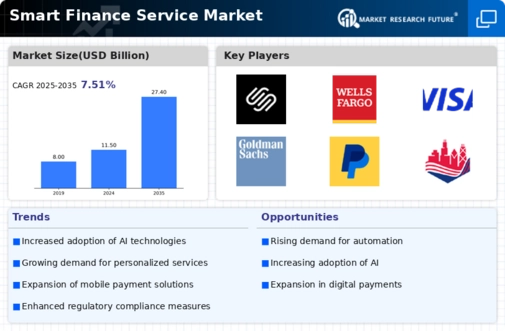The Smart Finance Service Market is currently characterized by a dynamic competitive landscape, driven by rapid technological advancements and evolving consumer preferences. Key players such as Ant Financial (CN), PayPal (US), and Stripe (US) are at the forefront, each adopting distinct strategies to enhance their market positioning. Ant Financial (CN) focuses on leveraging artificial intelligence and big data analytics to refine its service offerings, thereby enhancing customer experience and operational efficiency. Meanwhile, PayPal (US) emphasizes strategic partnerships and acquisitions to expand its ecosystem, particularly in the realm of digital wallets and payment solutions. Stripe (US), on the other hand, is heavily invested in simplifying payment processing for businesses, which positions it favorably in the growing e-commerce sector. Collectively, these strategies contribute to a competitive environment that is increasingly centered around innovation and customer-centric solutions.
In terms of business tactics, companies are increasingly localizing their services to cater to regional markets, optimizing their supply chains to enhance efficiency. The Smart Finance Service Market appears moderately fragmented, with a mix of established players and emerging startups. This fragmentation allows for diverse service offerings, yet the influence of key players remains substantial, as they set industry standards and drive technological advancements.
In August 2025, Ant Financial (CN) announced a partnership with a leading cloud service provider to enhance its AI capabilities, which is expected to streamline its financial services and improve risk management. This strategic move underscores Ant Financial's commitment to integrating cutting-edge technology into its operations, potentially setting a new benchmark for service efficiency in the market. The partnership may also enable Ant Financial to offer more personalized financial products, thereby attracting a broader customer base.
In September 2025, PayPal (US) launched a new feature that allows users to invest in cryptocurrencies directly through its platform. This initiative not only diversifies PayPal's service offerings but also positions it as a forward-thinking player in the evolving digital finance landscape. By facilitating cryptocurrency investments, PayPal is likely to attract a younger demographic, which could significantly enhance its market share in the fintech sector.
In July 2025, Stripe (US) expanded its operations into Southeast Asia, launching localized payment solutions tailored to the region's unique market needs. This expansion reflects Stripe's strategy to penetrate emerging markets, where digital payment adoption is rapidly increasing. By customizing its offerings, Stripe may gain a competitive edge, fostering deeper customer relationships and driving growth in a region with substantial untapped potential.
As of October 2025, the Smart Finance Service Market is witnessing trends such as increased digitalization, a focus on sustainability, and the integration of artificial intelligence. Strategic alliances are becoming increasingly pivotal, as companies collaborate to enhance their technological capabilities and service offerings. Looking ahead, competitive differentiation is likely to evolve, shifting from traditional price-based competition to a focus on innovation, technological advancement, and supply chain reliability. This transition may redefine how companies engage with consumers, emphasizing the importance of delivering value through cutting-edge solutions.
























